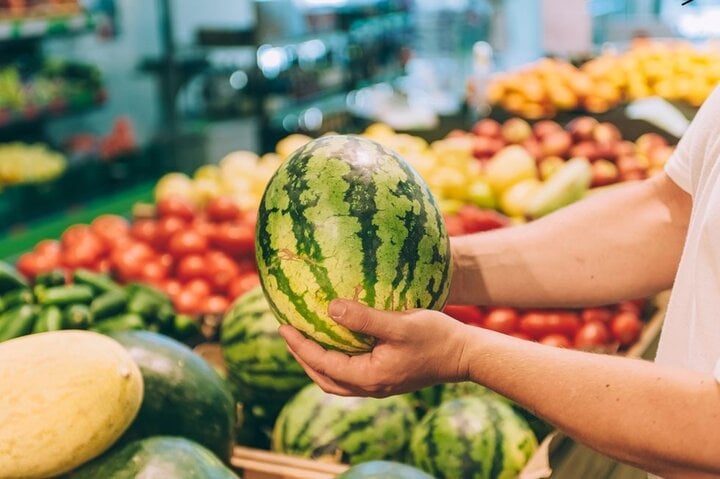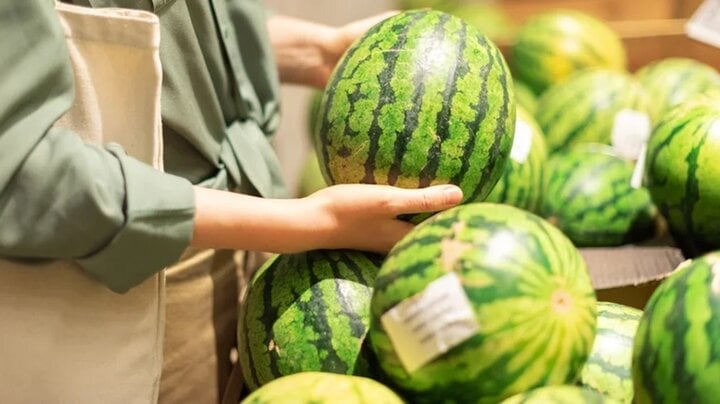Watermelon is a beloved summer fruit, not just for its refreshing taste but also for its abundance of vitamins and minerals.
When it comes to selecting the perfect watermelon, consumers often employ a popular and intriguing method: knocking on the melon to assess its ripeness and quality.
How does knocking on a watermelon indicate its sweetness?
The trick to choosing a sweet watermelon by knocking and listening for a deep sound stems from the age-old experience of farmers. Over time, through careful observation and experimentation, they discovered that watermelons producing deep and dull sounds when knocked on tend to be of the best quality.
This knowledge has been passed down and widely disseminated, becoming a familiar method used by many when buying watermelons.

Why does knocking on a watermelon indicate its sweetness? (Photo: Getty)
Watermelons have a hard outer shell and a fleshy interior with a high water content. When we knock on its surface, sound waves travel through this structure. Ripe and sweet watermelons usually have a higher water content and a denser structure, causing the sound waves to reflect clearly and consistently. If you hear a loud and hollow “thump,” it’s a sign that the watermelon is unripe, overripe, or spoiled. These watermelons tend to have soft, mushy flesh and are less sweet.
When you knock on a watermelon and hear a “thud,” it’s an indication of a ripe and sweet watermelon. This thud suggests that the flesh inside has matured sufficiently, becoming dense and leaving little air space, which signifies even ripeness, high sugar content, and a crisp texture. This method also helps identify fresh and tasty watermelons without having to cut them open.
Moreover, knocking on a watermelon provides information not only through sound but also through tactile sensation. When knocking on the surface of a watermelon, buyers can feel its responsiveness. A ripe and sweet watermelon gives a gentle and solid feel to the palm. An unripe or damaged watermelon may feel hollow or vibrate strongly but unevenly.
From a scientific perspective, knocking on a watermelon to listen for its sound is essentially a way to check for air pockets within the fruit. A watermelon with thick flesh and little air will produce a dull sound, while one with more air inside will result in a sharper tone.
British physicist Helen Czerski explains that when we tap an object, it deforms slightly and then quickly returns to its original state, oscillating and creating sound waves that are audible to human ears. This process occurs on a minute and rapid scale, generating sound waves.
Applying this principle to watermelons, we find that evenly ripened watermelons will have dense and symmetrical flesh with minimal air pockets. Consequently, the sound produced when tapped will be softer and duller. Conversely, an unripe or damaged watermelon will have asymmetrical flesh with more air spaces, resulting in a sharper or inconsistent sound.
How to choose a delicious watermelon
In addition to knocking on the watermelon, there are other factors to consider when selecting a sweet one. You can observe the color and shape of the fruit. A ripe watermelon will have a bright green color, and the yellow blotches (where it touched the ground) also indicate its ripeness. The shape should be symmetrical, without any deformities or dark spots.

Knocking on a watermelon is one way to choose a tasty one. (Photo: Getty)
The stem of the watermelon is also crucial. If the stem is dry and withered, it suggests that the fruit is ripe and was harvested not too long ago. Conversely, a fresh green stem indicates that the watermelon may not be fully ripe or was recently picked, possibly not reaching its maximum sweetness.
The navel of the watermelon (where the flower stem was attached before falling off) is another important indicator of its quality. Watermelons with larger navels tend to have thicker rinds and blander flesh, while those with smaller navels usually have thinner rinds and sweeter flesh.
Carefully choosing a watermelon not only enhances the culinary experience but also ensures the preservation of its nutritional value. Ripe watermelons are packed with water, vitamins A and C, and antioxidants essential for good health. The sweetness and crispness of a ripe watermelon elevate satisfaction and create a delightful eating experience, especially during hot summer days.
According to VTC
































